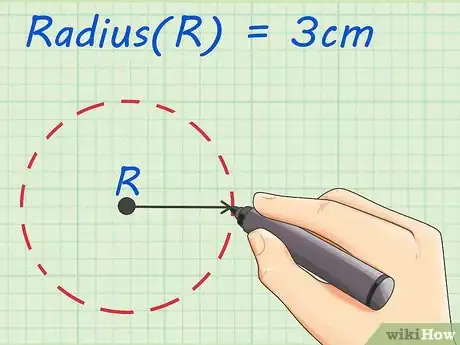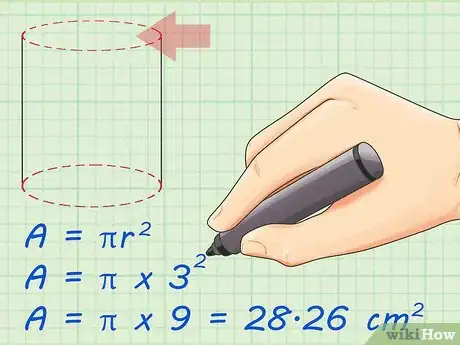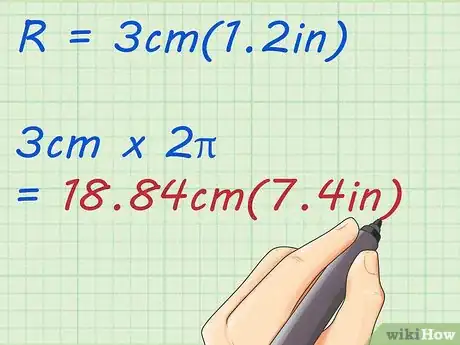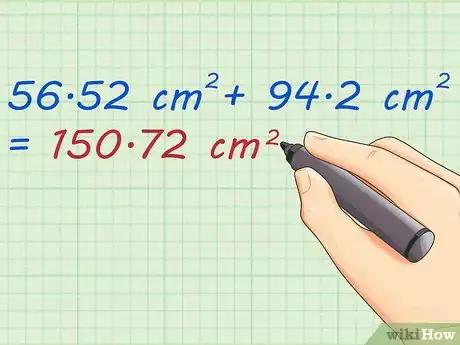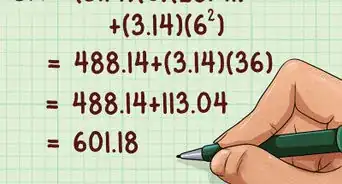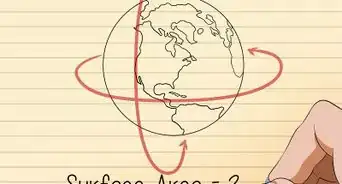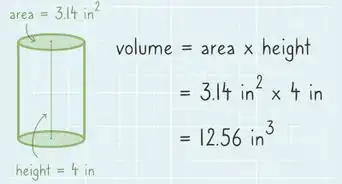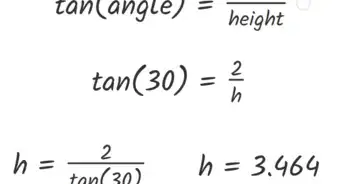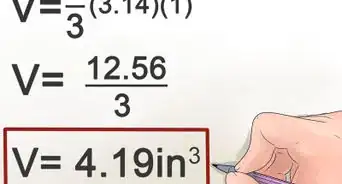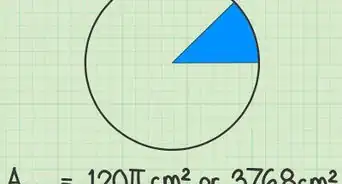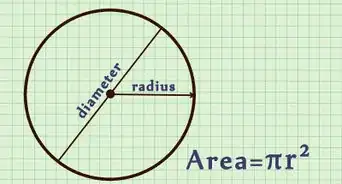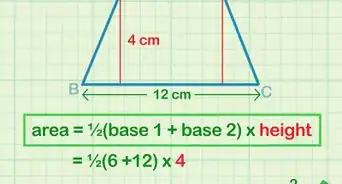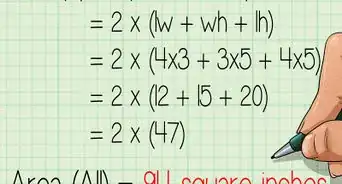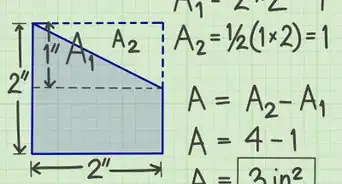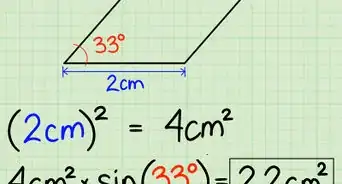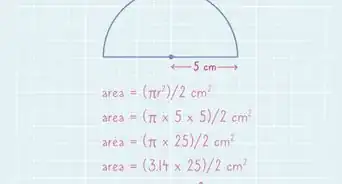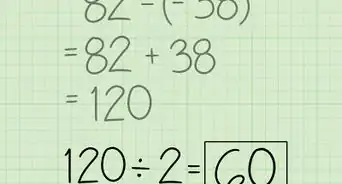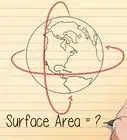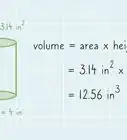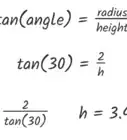This article was co-authored by wikiHow Staff. Our trained team of editors and researchers validate articles for accuracy and comprehensiveness. wikiHow's Content Management Team carefully monitors the work from our editorial staff to ensure that each article is backed by trusted research and meets our high quality standards.
This article has been viewed 431,550 times.
Learn more...
The surface area of a shape is the sum of the area of all of its faces. To find the area of a cylinder, you need to find the area of its bases and add that to the area of its outer wall. The formula for finding the area of a cylinder is A = 2πr2 + 2πrh.
Steps
Calculating the Surface Area of the Circles (2 x (π x r2))
-
1Visualize the top and bottom of a cylinder. A can of soup is the shape of a cylinder. If you think about it, the can has a top and a bottom that are the same. Both of these ends are the shape of a circle. The first step to finding the surface area of your cylinder will be to find the surface area of these circular ends.[1]
-
2Find the radius of your cylinder. The radius is the distance from the center of a circle to the outer edge of the circle. Radius is abbreviated “r.” The radius of your cylinder is the same as the radius of the top and bottom circles. In this example, the radius of the base is 3 centimeter (1.2 in).[2]
- If you are solving a word problem, the radius may be given. The diameter also might be given, which is the distance from one side of the circle to the other, passing through the center point. The radius is exactly one half the diameter.
- You can measure the radius with a ruler if you are looking for the surface area of an actual cylinder.
Advertisement -
3Calculate the surface area of the top circle. The surface area of a circle is equal to the number pi (~3.14) times the radius of the circle squared. The equation is written as π x r2. This is the same as saying π x r x r.[3]
- To find the area of the base, just plug the radius, 3 centimeter (1.2 in), into the equation for finding the area of a circle: A = πr2. Here's how you do it:
- A = πr2
- A = π x 32
- A = π x 9 = 28.26 cm2
-
4Do it again for the circle on the other side. Now that you have solved for the area of one base, you have to take into account the area of the second base. You can follow the same steps as you did with the first base, or you can recognize that the bases are identical. You can skip using the area equation a second time for the second base if you understand this.[4]
Calculating the Surface Area of the Edge (2π x r x h)
-
1Visualize the outside edge of a cylinder. When you visualize a cylindrical soup can, you should see a top and a bottom base. The bases are connected to each other by a “wall” of can. The radius of the wall is the same as the radius of the base, but unlike the base, the wall has height.[5]
-
2Find the circumference of one of the circles. You will need to find the circumference to find the surface area of the outer edge (also known as lateral surface area). To get the circumference, simply multiply the radius by 2π. So, the circumference can be found by multiplying 3 centimeter (1.2 in) by 2π. 3 centimeter (1.2 in) x 2π = 18.84 centimeter (7.4 in).[6]
-
3Multiply the circumference of the circle by the height of the cylinder. This will give you the outer edge surface area. Multiply the circumference, 18.84 centimeter (7.4 in), by the height, 5 centimeter (2.0 in). 18.84 centimeter (7.4 in) x 5 centimeter (2.0 in) = 94.2 cm2.[7]
Putting It Together ((2) x ( π x r2)) + (2π x r x h)
-
1Visualize the entire cylinder. First, you visualized how the top and bottom base and solved for the area contained on those surfaces. Next, you thought about the wall that extends between those bases and solved for that space. This time, think of the can as a whole, and you are solving for the entire surface.[8]
-
2Double the area of one base. Simply multiply the previous result, 28.26 cm2, by 2 to get the area of both bases. 28.26 x 2 = 56.52 cm2. This gives you the area of both bases.[9]
-
3Add the area of the wall and the base area. Once you add the area of the two bases and the outer surface area, you will have found the surface area of the cylinder. All you have to do is add 56.52 cm2, the area of both bases, and the outer surface area, 94.2 cm2. 56.52 cm2 + 94.2 cm2 = 150.72 cm2. The surface area with a cylinder with a height of 5 centimeter (2.0 in) and a circular base with a radius of 3 centimeter (1.2 in) is 150.72 cm2.[10]
Community Q&A
-
QuestionHow would I find the surface area of a cylinder when the diameter and height are given?
 Community AnswerDivide the diameter by 2 to get the radius, then follow the formula after that.
Community AnswerDivide the diameter by 2 to get the radius, then follow the formula after that. -
QuestionHow do I find the surface area with the circumference of the cylinder?
 Community AnswerFind the radius of one of the bases. Find the area of the base. Double the result to get the area of the top and bottom circles. Find the circumference of one of the circles. Multiply the circumference of the circle by the height of the cylinder. Add the lateral area and the base area.
Community AnswerFind the radius of one of the bases. Find the area of the base. Double the result to get the area of the top and bottom circles. Find the circumference of one of the circles. Multiply the circumference of the circle by the height of the cylinder. Add the lateral area and the base area. -
QuestionThree cylinders have bases that are the same size. The area of the base is 10.0 cm2. Determine the surface area of each cylinder, given its height. a) 8.0 cm b) 6.5 cm c) 9.4 cm
 Community AnswerStart by dividing the area of the base by pi. This will leave you with the radius squared (3.18 cm2). Next, take the square root of that to find your radius (1.78 cm). Multiply the radius by 2 pi to find the circumference (11.2 cm). Multiply the circumference by the height given and add the area of BOTH bases (20 cm2). This brings you to A) SA= 109.5 cm2 B) SA=92.7 cm2 C) SA=125.1 cm2.
Community AnswerStart by dividing the area of the base by pi. This will leave you with the radius squared (3.18 cm2). Next, take the square root of that to find your radius (1.78 cm). Multiply the radius by 2 pi to find the circumference (11.2 cm). Multiply the circumference by the height given and add the area of BOTH bases (20 cm2). This brings you to A) SA= 109.5 cm2 B) SA=92.7 cm2 C) SA=125.1 cm2.
Warnings
- Always remember to double the area of the base to account for the second base.⧼thumbs_response⧽
References
- ↑ https://sciencing.com/how-to-calculate-the-surface-area-of-a-circle-12751758.html
- ↑ https://www.cuemath.com/measurement/surface-area-of-cylinder/
- ↑ https://www.cuemath.com/measurement/base-area-of-cylinder/
- ↑ https://sciencing.com/how-to-calculate-the-surface-area-of-a-circle-12751758.html
- ↑ https://www.omnicalculator.com/math/surface-area-of-cylinder
- ↑ https://www.omnicalculator.com/math/surface-area-of-cylinder
- ↑ https://www.cuemath.com/geometry/cylinder/
- ↑ https://www.omnicalculator.com/math/surface-area-of-cylinder
- ↑ https://www.cuemath.com/measurement/surface-area-of-cylinder/
About This Article
To find the surface area of a cylinder, use the equation 2πr2 + 2πrh. Start by inserting the value of the radius of the circles and the height of the longest edge of the cylinder into the equation. Once you have all of the variables, begin solving the first part of the equation by squaring the radius, multiplying by pi, and then multiplying by 2. Solve the second part of the equation by multiplying the radius, height, and pi together, and then multiply by 2. To get the surface area of the cylinder, add the two values together and record your answer in units squared! If you need help finding the radius of the circles, keep reading the article!

